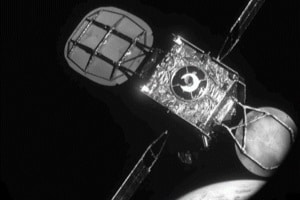Northrop Grumman Successfully Completes Historic First Docking of Mission Extension Vehicle with Intelsat 901 Satellite

MEV-1, launched Oct. 9, 2019, recently completed its orbit raising to an orbit approximately 180 miles above geosynchronous orbit. IS-901 is a fully operational communication satellite that is running low on fuel. Intelsat (NYSE: I) removed 901 from service in December 2019, transferring customers to other satellites in its extensive fleet, in order to raise its orbit to the same altitude as MEV-1 in preparation for docking. MEV-1 then completed the historic docking with IS-901 on February 25 at 2:15 a.m. ET. The combined spacecraft stack will now perform on-orbit checkouts before MEV-1 begins relocating the combined vehicle to return IS-901 into service in early April.
“Our Mission Extension Vehicle provides an innovative, satellite life extension service,” said Tom Wilson, president, SpaceLogistics LLC. “Together, Northrop Grumman, SpaceLogistics LLC and Intelsat have taken the first step in pioneering in-space logistics services for both commercial and government customers.”
“Intelsat has been at the forefront of innovation and game-changing space technology for decades. Pushing the boundaries of what’s possible is in our DNA here – that’s why we didn’t hesitate to sign up to be MEV-1’s first customer,” said Mike DeMarco, executive vice president and chief services officer at Intelsat. “We’re proud to make history with SpaceLogistics LLC and Northrop Grumman on this groundbreaking space milestone.”
Under the terms of the contract with Intelsat, MEV-1 will provide five years of life extension services to the IS-901 satellite before returning the spacecraft to a final decommissioning orbit. MEV-1 will then move on to provide mission extension services to a new client spacecraft.
MEV-1 was designed and built at the Northrop Grumman’s Dulles, Virginia, facility and utilizes a low-risk mechanical docking system that attaches to existing features on the client satellite. Once docked, MEV takes over the attitude and orbit maintenance of the combined vehicle stack to meet the pointing and station keeping requirements of the customer. MEV is designed for multiple docking and undockings and can deliver over 15 years of life extension services. The company is scheduled to launch its second Mission Extension Vehicle, MEV-2, later this year, which is contracted to provide service to a different Intelsat satellite.
This life extension service is just the first step in an expansive technology development plan. The company’s vision is to establish a fleet of satellite servicing vehicles that not only extend the life of satellites, but provide other services such as inclination changes and spacecraft inspections, as well as use advanced robotics technology to perform additional functions such as in-orbit repair and assembly.
As the foundational architects of satellite technology, Intelsat operates the world’s largest and most advanced satellite fleet and connectivity infrastructure. We apply our unparalleled expertise and global scale to connect people, businesses and communities, no matter how difficult the challenge. Intelsat is uniquely positioned to help our customers turn possibilities into reality – transformation happens when businesses, governments and communities use Intelsat’s next-generation global network and managed services to build their connected future.
Northrop Grumman solves the toughest problems in space, aeronautics, defense and cyberspace to meet the ever-evolving needs of our customers worldwide. Our 90,000 employees define possible every day using science, technology and engineering to create and deliver advanced systems, products and services.






















